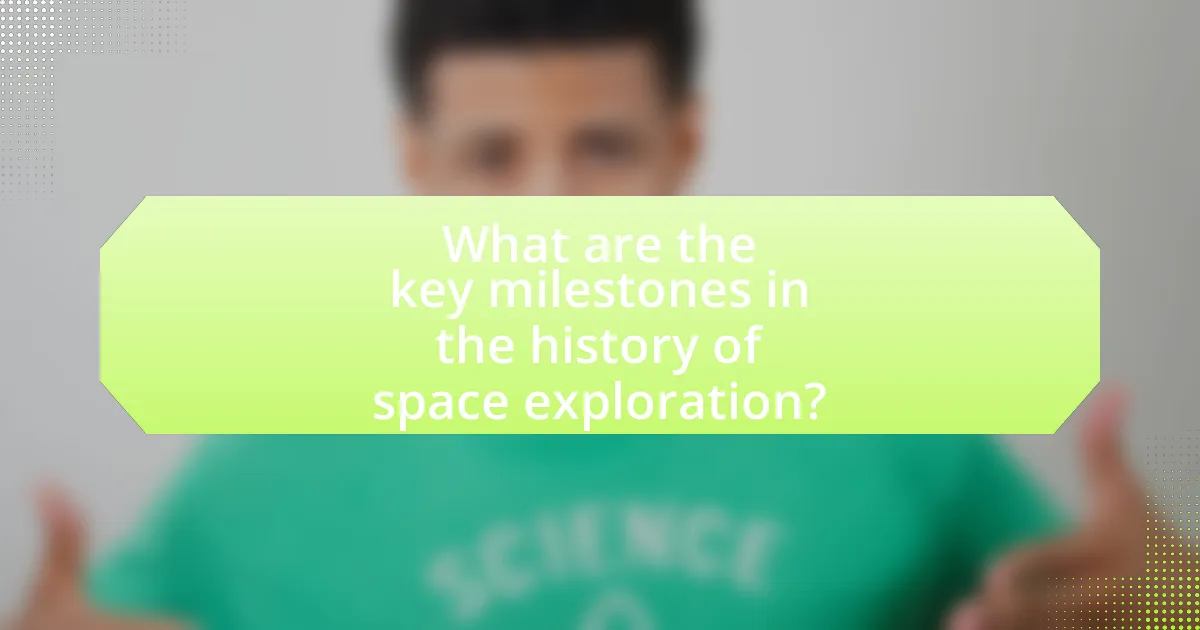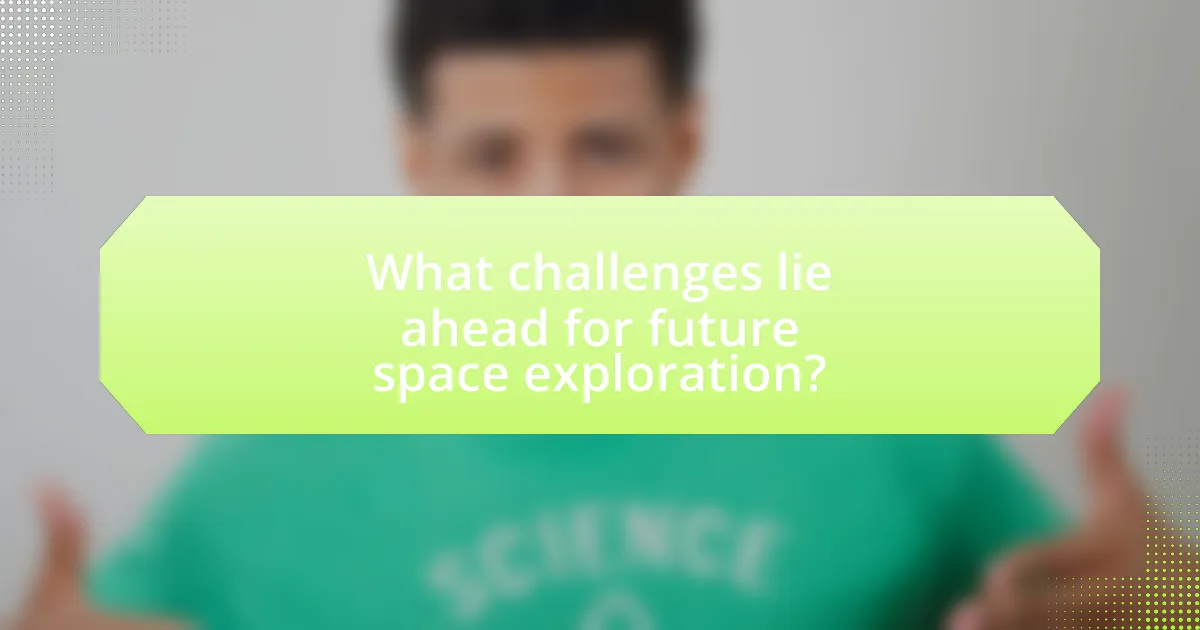The article “The Future of Space Exploration: Lessons from the Past” examines the significant milestones in space exploration history, including the launch of Sputnik 1, Yuri Gagarin’s first human spaceflight, and the Apollo 11 moon landing. It discusses how early missions shaped our understanding of space, the achievements of the Apollo program, and the influence of the Space Shuttle program on future missions. The article highlights current goals of space agencies, the role of private companies, and emerging technologies that will revolutionize exploration. Additionally, it addresses challenges such as health implications for astronauts, the need for sustainability, and ethical considerations in space exploration.

What are the key milestones in the history of space exploration?
The key milestones in the history of space exploration include the launch of Sputnik 1 in 1957, which marked the beginning of the space age as the first artificial satellite to orbit Earth. Following this, in 1961, Yuri Gagarin became the first human to travel into space aboard Vostok 1, demonstrating human capability in spaceflight. The Apollo 11 mission in 1969 achieved the first manned moon landing, with Neil Armstrong and Buzz Aldrin walking on the lunar surface, a significant achievement in human exploration. In 1975, the Apollo-Soyuz Test Project represented the first international human spaceflight mission, symbolizing cooperation between the United States and the Soviet Union. The launch of the Hubble Space Telescope in 1990 expanded our understanding of the universe by providing unprecedented images of distant galaxies. More recently, the Mars Rover missions, starting with Spirit and Opportunity in 2004, have significantly advanced our knowledge of the Martian environment. Each of these milestones has contributed to the evolution of space exploration and our understanding of the cosmos.
How did early space missions shape our understanding of space?
Early space missions significantly advanced our understanding of space by providing critical data about the Earth’s atmosphere, celestial bodies, and the effects of microgravity on biological organisms. For instance, the Vostok 1 mission in 1961, which carried Yuri Gagarin, revealed the feasibility of human spaceflight and the challenges posed by space travel. Additionally, the Apollo missions, particularly Apollo 11 in 1969, not only demonstrated lunar landing capabilities but also returned lunar samples that enhanced our knowledge of the Moon’s geology and formation. These missions laid the groundwork for subsequent exploration and scientific inquiry, establishing foundational principles in astrobiology, planetary science, and space technology.
What were the significant achievements of the Apollo program?
The significant achievements of the Apollo program include landing humans on the Moon, advancing space technology, and fostering international collaboration in space exploration. The Apollo 11 mission, which took place in July 1969, marked the first successful manned Moon landing, with astronauts Neil Armstrong and Buzz Aldrin walking on the lunar surface. This event demonstrated the feasibility of human space travel beyond Earth and inspired future missions. Additionally, the program led to the development of critical technologies, such as the Saturn V rocket, which remains one of the most powerful rockets ever built. The Apollo program also established a framework for international cooperation in space, as seen in subsequent partnerships like the International Space Station.
How did the Space Shuttle program influence future missions?
The Space Shuttle program significantly influenced future missions by establishing a reusable spacecraft model that reduced costs and increased access to space. This program, operational from 1981 to 2011, demonstrated the feasibility of long-duration missions and the importance of modular design, which allowed for the assembly of larger structures in orbit, such as the International Space Station. The program’s experience with human spaceflight, including safety protocols and mission planning, directly informed the development of subsequent missions, such as NASA’s Artemis program aimed at returning humans to the Moon and eventually sending astronauts to Mars. The Shuttle’s legacy also includes advancements in technology and engineering practices that continue to shape modern spacecraft design and mission architecture.
What lessons have we learned from past space exploration efforts?
Past space exploration efforts have taught us the importance of international collaboration and the need for robust safety protocols. For instance, the Apollo program demonstrated that joint missions, like the Apollo-Soyuz Test Project in 1972, can foster diplomatic relations and share technological advancements. Additionally, the Challenger and Columbia disasters highlighted the critical need for rigorous safety measures and risk management in space missions, leading to the implementation of more stringent testing and review processes by NASA. These lessons emphasize that successful future exploration relies on cooperation and a commitment to safety.
How have failures in space missions contributed to safety improvements?
Failures in space missions have significantly contributed to safety improvements by highlighting critical vulnerabilities in technology and operational protocols. For instance, the Challenger disaster in 1986 revealed flaws in the O-ring seals of the solid rocket boosters, leading to enhanced testing and redesign of components to ensure reliability under extreme conditions. Similarly, the Columbia disaster in 2003 prompted NASA to implement more rigorous safety checks and improve communication protocols among teams, resulting in a culture of safety that prioritizes risk assessment. These incidents have led to the establishment of comprehensive safety frameworks, such as the implementation of the NASA Safety Management System, which systematically identifies and mitigates risks in future missions.
What technological advancements emerged from historical space exploration?
Technological advancements that emerged from historical space exploration include satellite technology, GPS, and advancements in materials science. Satellite technology, developed for communication and Earth observation during the space race, has become integral to global communications and weather forecasting. The Global Positioning System (GPS), initially created for military navigation, now serves billions worldwide for navigation and location services. Additionally, advancements in materials science, such as heat-resistant materials used in spacecraft, have led to innovations in various industries, including aerospace and automotive. These developments demonstrate the significant impact of space exploration on everyday technology and industry.

How is the future of space exploration being shaped today?
The future of space exploration is being shaped today by advancements in technology, international collaboration, and the increasing involvement of private companies. Technological innovations, such as reusable rocket systems developed by SpaceX, have significantly reduced launch costs and increased access to space. International partnerships, exemplified by the Artemis program involving NASA and other space agencies, aim to return humans to the Moon and establish a sustainable presence there by the end of the decade. Additionally, private companies like Blue Origin and Virgin Galactic are expanding commercial spaceflight opportunities, which fosters a new era of exploration and research. These developments indicate a shift towards a more collaborative and commercially-driven approach to space exploration, enhancing capabilities and expanding the scope of future missions.
What are the current goals of space agencies around the world?
The current goals of space agencies around the world include advancing human exploration of Mars, enhancing Earth observation capabilities, and developing sustainable lunar exploration programs. NASA aims to return humans to the Moon by 2024 through the Artemis program, which will serve as a stepping stone for future Mars missions. The European Space Agency focuses on climate monitoring and Earth observation through missions like Copernicus, which provides critical data on environmental changes. Additionally, agencies like Roscosmos and CNSA are working on establishing permanent lunar bases and conducting crewed missions to Mars, reflecting a global commitment to expanding human presence beyond Earth. These goals are supported by international collaborations, such as the Artemis Accords, which promote peaceful exploration and shared scientific knowledge.
How are international collaborations influencing space exploration?
International collaborations are significantly enhancing space exploration by pooling resources, expertise, and technology from various countries. For instance, the International Space Station (ISS) is a prime example, involving partnerships between NASA, Roscosmos, ESA, JAXA, and CSA, which has led to advancements in scientific research and technology development. These collaborations enable shared funding, reducing individual costs and risks associated with space missions. Additionally, joint missions, such as the Mars Sample Return project, leverage diverse scientific knowledge and capabilities, increasing the likelihood of successful outcomes. The collaborative framework fosters innovation and accelerates the pace of exploration, as seen in the Artemis program, where international partnerships are crucial for lunar exploration goals.
What role do private companies play in the future of space travel?
Private companies are pivotal in shaping the future of space travel by driving innovation, reducing costs, and increasing access to space. Companies like SpaceX and Blue Origin have developed reusable rocket technology, significantly lowering launch expenses; for instance, SpaceX’s Falcon 9 has reduced the cost of sending payloads to orbit by approximately 90% compared to traditional methods. Furthermore, private enterprises are expanding the market for satellite launches and space tourism, evidenced by SpaceX’s Crew Dragon missions, which have successfully transported astronauts to the International Space Station. This involvement not only accelerates advancements in technology but also fosters competition, leading to more efficient and diverse space exploration initiatives.
What emerging technologies are set to revolutionize space exploration?
Emerging technologies set to revolutionize space exploration include reusable launch systems, advanced propulsion methods, artificial intelligence, and in-situ resource utilization. Reusable launch systems, exemplified by SpaceX’s Falcon 9, significantly reduce costs by allowing rockets to be flown multiple times. Advanced propulsion methods, such as ion propulsion and nuclear thermal propulsion, promise faster travel times and greater efficiency for deep space missions. Artificial intelligence enhances mission planning and autonomous navigation, improving safety and operational efficiency. In-situ resource utilization enables the extraction of resources from celestial bodies, reducing the need for resupply from Earth. These technologies collectively enhance the feasibility and sustainability of future space exploration missions.
How will advancements in propulsion systems impact future missions?
Advancements in propulsion systems will significantly enhance the efficiency and reach of future space missions. Improved propulsion technologies, such as ion thrusters and nuclear thermal propulsion, enable spacecraft to achieve higher speeds and reduce travel times to distant destinations, such as Mars or the outer planets. For instance, NASA’s recent tests of the Solar Electric Propulsion system demonstrated a potential reduction in travel time to Mars by up to 50%, showcasing the tangible benefits of these advancements. Additionally, more efficient propulsion systems can lower fuel requirements, allowing for larger payloads and extended mission durations, which are critical for deep-space exploration.
What is the significance of artificial intelligence in space exploration?
Artificial intelligence is significant in space exploration as it enhances data analysis, automates operations, and improves decision-making processes. AI systems can process vast amounts of data collected from space missions, enabling scientists to identify patterns and make discoveries more efficiently. For instance, NASA’s Mars Rover uses AI to navigate autonomously, allowing it to make real-time decisions without waiting for instructions from Earth, which can take several minutes due to the distance. Additionally, AI algorithms are employed in analyzing satellite imagery, helping to monitor climate change and track natural disasters. These applications demonstrate AI’s critical role in advancing our understanding of space and improving mission outcomes.

What challenges lie ahead for future space exploration?
Future space exploration faces significant challenges, including technological limitations, funding constraints, and the need for international collaboration. Technological limitations encompass the development of reliable propulsion systems, life support technologies, and radiation protection, which are crucial for long-duration missions beyond low Earth orbit. Funding constraints arise from the high costs associated with space missions, which require sustained investment from governments and private entities; for instance, NASA’s budget for 2023 was approximately $25.4 billion, highlighting the financial demands of ambitious projects. Additionally, international collaboration is essential to address the complexities of space governance, resource sharing, and safety protocols, as demonstrated by the success of the International Space Station, which involved multiple countries working together. These challenges must be addressed to ensure the success and sustainability of future space exploration endeavors.
How can we address the risks associated with long-duration space missions?
To address the risks associated with long-duration space missions, implementing comprehensive health monitoring systems and psychological support programs is essential. Research indicates that astronauts face significant physical and mental health challenges during extended missions, including muscle atrophy, bone density loss, and psychological stress. For instance, NASA’s Twin Study demonstrated that prolonged spaceflight can lead to changes in gene expression and immune function. Additionally, providing regular exercise regimens and nutritional support can mitigate physical health risks, while establishing robust communication channels with Earth can alleviate feelings of isolation and anxiety. These strategies collectively enhance crew resilience and mission success.
What are the health implications for astronauts on extended missions?
Astronauts on extended missions face significant health implications, including muscle atrophy, bone density loss, and psychological challenges. Research indicates that microgravity environments lead to a decrease in muscle mass and strength, with studies showing a loss of approximately 1% to 2% of muscle mass per month in space. Additionally, astronauts experience a reduction in bone density at a rate of about 1% to 2% per month, increasing the risk of fractures. Psychological effects, such as anxiety and depression, can arise due to isolation and confinement, as evidenced by NASA’s studies on long-duration missions. These health risks necessitate comprehensive countermeasures to ensure astronaut well-being during future space exploration missions.
How can we ensure the sustainability of human presence in space?
To ensure the sustainability of human presence in space, we must develop closed-loop life support systems that recycle air, water, and waste. These systems are essential for long-duration missions, as demonstrated by the International Space Station, which has successfully recycled over 90% of its water. Additionally, utilizing in-situ resource utilization (ISRU) technologies to extract resources from celestial bodies, such as water from lunar ice or Martian soil, can significantly reduce the need for resupply missions from Earth. Research from NASA’s Artemis program indicates that establishing a sustainable lunar base can serve as a testing ground for these technologies, ultimately supporting human missions to Mars and beyond.
What ethical considerations must be taken into account for future missions?
Future missions must prioritize the ethical treatment of potential extraterrestrial life and the preservation of celestial environments. Ethical considerations include ensuring that missions do not contaminate other planets or moons, which could compromise scientific research and the integrity of those ecosystems. For instance, the Outer Space Treaty of 1967 emphasizes the need for responsible exploration and the avoidance of harmful interference with celestial bodies. Additionally, the rights and interests of all stakeholders, including future generations and international communities, must be respected in decision-making processes. This approach aligns with the principles of sustainability and stewardship, which are increasingly recognized as essential in the context of space exploration.
How do we balance exploration with the preservation of extraterrestrial environments?
Balancing exploration with the preservation of extraterrestrial environments requires implementing strict regulatory frameworks and adopting sustainable technologies. Regulatory bodies, such as the Outer Space Treaty, emphasize the need for responsible exploration to prevent contamination and protect celestial bodies. For instance, NASA’s Planetary Protection Policy mandates that missions to potentially habitable environments, like Mars, must minimize biological contamination to preserve their integrity. Additionally, employing technologies like robotic exploration reduces human impact, allowing for data collection without direct interference. These measures ensure that exploration efforts do not compromise the scientific value and ecological integrity of extraterrestrial environments.
What policies are needed to govern space exploration activities?
Comprehensive policies needed to govern space exploration activities include international treaties, regulatory frameworks, and ethical guidelines. International treaties, such as the Outer Space Treaty of 1967, establish principles for the peaceful use of outer space and prohibit the appropriation of celestial bodies. Regulatory frameworks are essential for managing commercial space activities, ensuring safety, and protecting the environment, as seen in the U.S. Federal Aviation Administration’s regulations for commercial launches. Ethical guidelines are necessary to address issues like planetary protection and the potential for space debris, which can impact both current and future missions. These policies collectively ensure that space exploration is conducted responsibly and sustainably.
What practical steps can we take to prepare for the future of space exploration?
To prepare for the future of space exploration, we can invest in advanced technologies, enhance international collaboration, and prioritize education in STEM fields. Investing in technologies such as reusable rockets and in-situ resource utilization can reduce costs and increase mission sustainability, as demonstrated by SpaceX’s Falcon 9 and NASA’s Artemis program. Enhancing international collaboration, as seen in the International Space Station partnership, can pool resources and expertise, fostering innovation and shared goals. Prioritizing education in STEM fields ensures a skilled workforce capable of tackling complex challenges in space exploration, which is critical given that the U.S. Bureau of Labor Statistics projects a 10% growth in aerospace engineering jobs from 2020 to 2030.
How can education and public engagement enhance interest in space exploration?
Education and public engagement can significantly enhance interest in space exploration by fostering curiosity and providing accessible knowledge about space science. Programs like NASA’s “STEM Engagement” initiatives have shown that when students participate in hands-on activities related to space, such as building rockets or engaging in simulations, their interest in pursuing careers in science and engineering increases. For instance, a study by the National Science Foundation found that students involved in such programs are 50% more likely to pursue STEM degrees. Additionally, public engagement through events like space-themed festivals and community lectures can demystify space exploration, making it relatable and exciting for a broader audience. This approach not only informs the public but also creates a sense of community around space initiatives, as evidenced by the growing attendance at events like the annual International Space Development Conference, which attracts thousands of participants interested in space topics.
What skills will be essential for future space explorers and scientists?
Future space explorers and scientists will require skills in advanced technology, problem-solving, teamwork, and adaptability. Advanced technology skills are crucial as space missions increasingly rely on sophisticated systems and equipment, such as robotics and artificial intelligence. Problem-solving abilities are essential for addressing unexpected challenges in the harsh environment of space, where conditions can change rapidly. Teamwork is vital, as collaboration among diverse specialists enhances mission success, evidenced by the effectiveness of international teams on the International Space Station. Lastly, adaptability is necessary to thrive in unpredictable situations, a skill highlighted by NASA’s Mars rover missions, where engineers had to modify plans based on real-time data.
